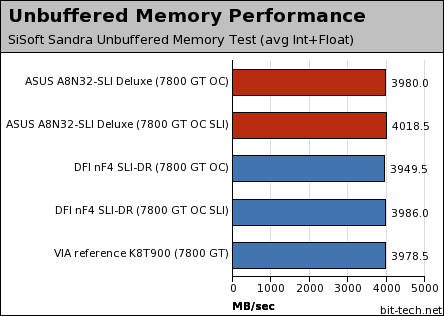Testing Methods:
With the exception of SiSoft Sandra's unbuffered memory bandwidth benchmark - which, incidentally, measures real memory bandwidth when you need it most - all of our benchmarks have been engineered to give you numbers that you are likely to find useful when actually using the products we have evaluated in the real world. There are plans to increase the number of benchmarks over time and we're running additional tests that will not be published until we have enough products to make a reasonable comparison.We are also focusing a lot more of our time on evaluating the stability of the motherboards (and platforms) using a stress test designed to highlight any of the potential weaknesses that the product may have. That involves a gradually increasing amount of stress starting with Prime95 and expanding to IOMeter and 3DMark03 if all is well. This is to ensure that all parts of the system are stressed simultaneously over a period of time.
We believe that the consumer is never likely to subject their platform to this level of stress and we are not expecting every product to complete an entire extended stress test. However, most poorly engineered products fail within the first couple of hours, or even minutes, allowing us to make a conscious decision on whether a motherboard (or platform) is worth your money, regardless of how well it performs in our benchmarks.
Test Setup:
AMD Athlon 64 FX-57 (operating at 2800MHz - 14x200); ASUS A8N32-SLI Deluxe (nForce4 SLI x16); 2 x 512MB Corsair 3200XL Pro (operating in dual channel with 2.0-2-2-7-1T timings); 2 x BFGTech GeForce 7800 GT OC (operating at 425/1050MHz); Maxtor DiamondMax 10 250GB 7,200RPM SATA 150 hard disk drive; Windows XP Professional Service Pack 2; DirectX 9.0c; NVIDIA Forceware 81.94.AMD Athlon 64 FX-57 (operating at 2800MHz - 14x200); VIA K8T900 Reference Motherboard; 2 x 512MB Corsair 3200XL Pro (operating in dual channel with 2.0-2-2-7-1T timings); BFGTech GeForce 7800 GT OC (operating at 425/1050MHz); Maxtor DiamondMax 10 250GB 7,200RPM SATA 150 hard disk drive; Windows XP Professional Service Pack 2; DirectX 9.0c; NVIDIA Forceware 81.94.
AMD Athlon 64 FX-57 (operating at 2800MHz - 14x200); DFI LANParty nF4 SLI-DR (nForce4 SLI); 2 x 512MB Corsair 3200XL Pro (operating in dual channel with 2.0-2-2-7-1T timings); 2 x BFGTech GeForce 7800 GT OC (operating at 425/1050MHz); Maxtor DiamondMax 10 250GB 7,200RPM SATA 150 hard disk drive; Windows XP Professional Service Pack 2; DirectX 9.0c; NVIDIA Forceware 81.94
Memory Performance:

Stability & Overclocking:
As we have come to expect from ASUS, this board was as stable as any other motherboard that we've ever tested. It didn't matter how much we tortured it - it didn't give us the slightest hint that it was going to falter. We ran it through our normal stress testing sequence - consisting of Prime95, IOMeter and 3DMark03 - for well over 24 hours. This board was so stable that we're confident it would have kept on going for another 24 hours too.We managed to get the ASUS A8N32-SLI to run Prime95 stable at 10x279MHz with our OCZ Platinum PC5000 memory running in sync at 279MHz 2.5-3-3-7. However, we felt that the CPU's memory controller was letting the overclock down somewhat, as we've had problems getting above roughly 285MHz 1:1 in the past.
We also tried overclocking the board with our memory running with the 166MHz memory divider with hope that it would eliminate our memory controller bottleneck. We did find that there were some improvements, as we were able to get the motherboard stable at 308MHz HTT using the 9.0x CPU multiplier. The memory was running at just over 250MHz at these settings.

MSI MPG Velox 100R Chassis Review
October 14 2021 | 15:04







Want to comment? Please log in.